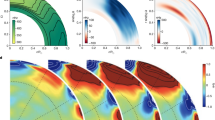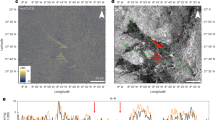Abstract
THE radio beacon experiment1–3 aboard the geostationary Applied Technology Satellite ATS-6 enables the determination of total electron content (TEC) to be made by two independent methods. The first—the Faraday polarisation rotation technique—has been widely used in obtaining TEC data. Faraday rotation is dependent on the Earth's magnetic field, and, since its magnitude is heavily weighted near the Earth, it is considered to provide integrated electron content values for altitudes below ∼1,500 km. The second—the dispersive-group-delay technique, in which the phase of the modulation envelope between a carrier and its sideband is compared at two frequencies—is independent of the Earth's magnetic field and thus yields the integrated electron content between the observer and the satellite signal source. The Faraday content, NF, and the dispersive-group-delay content, NT, therefore, yield the TEC up to ∼1,500 km and geostationary altitudes, respectively. The difference between NT and NF yields the content above ∼1,500 km, which is referred to as the plasmaspheric content, Np.
This is a preview of subscription content, access via your institution
Access options
Subscribe to this journal
Receive 51 print issues and online access
$199.00 per year
only $3.90 per issue
Buy this article
- Purchase on Springer Link
- Instant access to full article PDF
Prices may be subject to local taxes which are calculated during checkout
Similar content being viewed by others
References
Davies, K., Fritz, R. B., and Grubb, R. N., J. Environ. Sci., 15, 31–35 (1972).
Soicher, H., Nature, 253, 252–254 (1795).
Soicher, H., Proc. COSPAR Symposium on “The Geophysical Use of Satellite Beacon Observations”, 1–4 June 1976 Boston (Publisher and location, in the press).
Eccles, D., and King, J. W., Proc. IEEE, 57, 1012–1018 (1969).
Zmuda, A. J., J. Geophys. Res., 71, 1911–1917 (1966).
De Mendonca, F., Space Res., V, 687–701 (1965).
Muldrew, D. B., J. Geophys. Res., 70, 2635–2650 (1975).
Lizka, L., Radio Science (New Series), 1, (10), 1135–1137 (1966).
Author information
Authors and Affiliations
Rights and permissions
About this article
Cite this article
SOICHER, H. Comparative ionospheric and plasmaspheric electron contents from three world regions. Nature 264, 46–48 (1976). https://doi.org/10.1038/264046a0
Received:
Accepted:
Issue Date:
DOI: https://doi.org/10.1038/264046a0
Comments
By submitting a comment you agree to abide by our Terms and Community Guidelines. If you find something abusive or that does not comply with our terms or guidelines please flag it as inappropriate.



